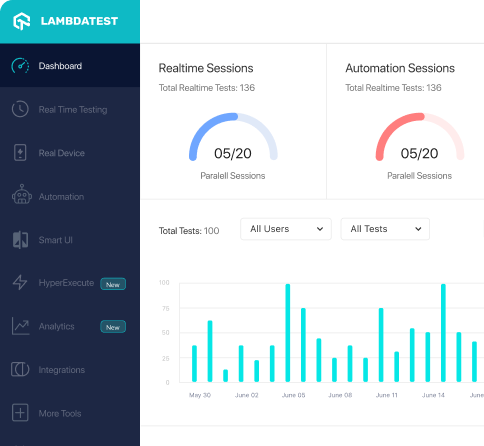How to use ExecuteSQLIT class of com.consol.citrus.actions package
Best Citrus code snippet using com.consol.citrus.actions.ExecuteSQLIT
Source: ExecuteSQLIT.java
...20/**21 * @author Christoph Deppisch22 * @since 200823 */24public class ExecuteSQLIT extends AbstractTestNGCitrusTest {25 @Test26 @CitrusXmlTest27 public void ExecuteSQLIT() {}28}...ExecuteSQLIT
Using AI Code Generation
1ExecuteSQLIT executeSQLIT = new ExecuteSQLIT();2executeSQLIT.setDataSource(dataSource);3executeSQLIT.setSqlResource("classpath:com/consol/citrus/sql/insert.sql");4executeSQLIT.setStatementType(StatementType.PREPARED_STATEMENT);5executeSQLIT.setSqlParameters(new Object[] { "citrus:concat('Hello', 'World')", 1, 1.0, 10, 100L, new Date() });6executeSQLIT.setFetchSize(1);7executeSQLIT.setFetchDirection(ResultSet.FETCH_FORWARD);8executeSQLIT.setQueryTimeout(1000);9executeSQLIT.setValidateScript("classpath:com/consol/citrus/sql/validate.sql");10executeSQLIT.setValidateScriptStatementType(StatementType.PREPARED_STATEMENT);11executeSQLIT.setValidateScriptParameters(new Object[] { "citrus:concat('Hello', 'World')", 1, 1.0, 10, 100L, new Date() });12executeSQLIT.setValidateScriptFetchSize(1);13executeSQLIT.setValidateScriptFetchDirection(ResultSet.FETCH_FORWARD);14executeSQLIT.setValidateScriptQueryTimeout(1000);15executeSQLIT.setValidateScriptResultSetHandler(resultSetHandler);ExecuteSQLIT
Using AI Code Generation
1ExecuteSQLIT executeSQLIT = new ExecuteSQLIT();2executeSQLIT.setDataSource(dataSource);3executeSQLIT.setSqlResource("classpath:com/consol/citrus/actions/sql/select.sql");4executeSQLIT.setResultSetHandler(new RowCountResultSetHandler());5executeSQLIT.setRowMapper(new RowMapper<Map<String, Object>>() {6 public Map<String, Object> mapRow(ResultSet rs, int rowNum) throws SQLException {7 Map<String, Object> row = new HashMap<>();8 row.put("id", rs.getString("ID"));9 row.put("name", rs.getString("NAME"));10 row.put("description", rs.getString("DESCRIPTION"));11 return row;12 }13});14executeSQLIT.setVariable("result", "sqlResult");15executeSQLIT.setValidationCallback(new ResultSetValidationCallback() {16 public void validate(ResultSet rs, TestContext context) throws SQLException {17 Assert.assertEquals(rs.getString("ID"), "1234");18 Assert.assertEquals(rs.getString("NAME"), "Citrus");19 Assert.assertEquals(rs.getString("DESCRIPTION"), "Citrus rocks!");20 }21});22SQLServer sqlServer = new SQLServer();ExecuteSQLIT
Using AI Code Generation
1ExecuteSQLIT executeSQLIT=new ExecuteSQLIT();2executeSQLIT.setDataSource(dataSource);3executeSQLIT.setSqlResource("classpath:sql/select.sql");4executeSQLIT.setRowMapper(new RowMapper<User>() {5public User mapRow(ResultSet rs, int rowNum) throws SQLException {6User user=new User();7user.setId(rs.getInt("ID"));8user.setName(rs.getString("NAME"));9user.setAge(rs.getInt("AGE"));10return user;11}12});13executeSQLIT.setVariable("user", "citrus:currentRow");14executeSQLIT.setVariable("name", "citrus:currentRow.name");15executeSQLIT.setVariable("age", "citrus:currentRow.age");16executeSQLIT.setVariable("id", "citrus:currentRow.id");17executeSQLIT.setSqlResourcePath("classpath:sql/");18executeSQLIT.setSqlResourceName("select.sql");19executeSQLIT.setSqlResourceParameters(Collections.singletonMap("id", 1));20executeSQLIT.setSqlResourceParameters(Collections.singletonMap("id", "citrus:currentRow.id"));21executeSQLIT.setSqlResourceParameters(Collections.singletonMap("id", "${id}"));22executeSQLIT.setSqlResourceParameters(Collections.singletonMap("id", "1"));23executeSQLIT.setSqlResourceParameters(Collections.singletonMap("id", "${id}"));24executeSQLIT.setSqlResourceParameters(Collections.singletonMap("id", "citrus:currentRow.id"));25executeSQLIT.setSqlResourceParameters(Collections.singletonMap("id", "1"));26executeSQLIT.setSqlResourceParameters(Collections.singletonMap("id", "${id}"));27executeSQLIT.setSqlResourceParameters(Collections.singletonMap("id", "citrus:currentRow.id"));28executeSQLIT.setSqlResourceParameters(Collections.singletonMap("id", "1"));29executeSQLIT.setSqlResourceParameters(Collections.singletonMap("id", "${id}"));30executeSQLIT.setSqlResourceParameters(Collections.singletonMap("id", "citrus:currentRow.id"));31executeSQLIT.setSqlResourceParameters(Collections.singletonMap("id", "1"));32executeSQLIT.setSqlResourceParameters(Collections.singletonMap("id", "${id}"));33executeSQLIT.setSqlResourceParameters(Collections.singletonMap("id", "citrus:currentRow.id"));34executeSQLIT.setSqlResourceParameters(Collections.singletonMap("id", "1"));35executeSQLIT.setSqlResourceParameters(Collections.singletonMap("id", "${id}"));36executeSQLIT.setSqlResourceParameters(Collections.singletonMap("id", "citrus:currentExecuteSQLIT
Using AI Code Generation
1ExecuteSQLIT sql = new ExecuteSQLIT();2sql.setDataSource(dataSource);3sql.setSqlResourcePath("classpath:com/mycompany/test/sql/test.sql");4sql.setSqlResourcePath("classpath:com/mycompany/test/sql/test.sql");5sql.setVariable("test", "test");6sql.setSqlResourcePath("classpath:com/mycompany/test/sql/test.sql");7sql.setSqlResourcePath("classpath:com/mycompany/test/sql/test.sql");8sql.setVariable("test", "test");9sql.setSqlResourcePath("classpath:com/mycompany/test/sql/test.sql");10sql.setSqlResourcePath("classpath:com/mycompany/test/sql/test.sql");11sql.setVariable("test", "test");12sql.setSqlResourcePath("classpath:com/mycompany/test/sql/test.sql");13sql.setSqlResourcePath("classpath:com/mycompany/test/sql/test.sql");14sql.setVariable("test", "test");15sql.setSqlResourcePath("classpath:com/mycompany/test/sql/test.sql");16sql.setSqlResourcePath("classpath:com/mycompany/test/sql/test.sql");17sql.setVariable("test", "test");18sql.setSqlResourcePath("classpath:com/mycompany/test/sql/test.sql");19sql.setSqlResourcePath("classpath:com/mycompany/test/sql/test.sql");20sql.setVariable("test", "test");21sql.setSqlResourcePath("classpath:com/mycompany/test/sql/test.sql");22sql.setSqlResourcePath("classpath:com/mycompany/test/sql/test.sql");23sql.setVariable("test", "test");24sql.setSqlResourcePath("classpath:com/mycompany/test/sql/test.sql");25sql.setSqlResourcePath("classpath:com/mycompany/test/sql/test.sql");26sql.setVariable("test", "test");27sql.setSqlResourcePath("classpath:com/mycompany/test/sql/test.sql");28sql.setSqlResourcePath("classpath:com/mycompany/test/sql/test.sql");29sql.setVariable("test", "test");30sql.setSqlResourcePath("classpath:com/mycompany/test/sql/test.sql");31sql.setSqlResourcePath("classpath:com/mycompany/test/sql/test.sql");32sql.setVariable("test", "test");33sql.setSqlResourcePath("classpath:com/mycompany/test/sql/test.sql");34sql.setSqlResourcePath("classpath:com/mycompany/test/sql/test.sql");35sql.setVariable("test", "test");36sql.setSqlResourcePath("classpath:com/mycompany/test/sql/test.sql");37sql.setSqlResourcePath("classpath:com/mycompany/test/sql/test.sql");ExecuteSQLIT
Using AI Code Generation
1ExecuteSQLIT sqlIT = new ExecuteSQLIT();2sqlIT.setDataSource(dataSource);3sqlIT.setSqlQuery("SELECT * FROM CUSTOMER WHERE ID = 1");4sqlIT.setVariable("customer");5sqlIT.setRowMapper(new RowMapper<Customer>() {6 public Customer mapRow(ResultSet resultSet, int i) throws SQLException {7 return new Customer(resultSet.getInt("ID"), resultSet.getString("NAME"), resultSet.getString("ADDRESS"));8 }9});10sqlIT.setRowMapper(new RowMapper<Customer>() {11 public Customer mapRow(ResultSet resultSet, int i) throws SQLException {12 return new Customer(resultSet.getInt("ID"), resultSet.getString("NAME"), resultSet.getString("ADDRESS"));13 }14});15sqlIT.setRowMapper(new RowMapper<Customer>() {16 public Customer mapRow(ResultSet resultSet, int i) throws SQLException {17 return new Customer(resultSet.getInt("ID"), resultSet.getString("NAME"), resultSet.getString("ADDRESS"));18 }19});20sqlIT.setRowMapper(new RowMapper<Customer>() {21 public Customer mapRow(ResultSet resultSet, int i) throws SQLException {22 return new Customer(resultSet.getInt("ID"), resultSet.getString("NAME"), resultSet.getString("ADDRESS"));23 }24});25sqlIT.setRowMapper(new RowMapper<Customer>() {26 public Customer mapRow(ResultSet resultSet, int i) throws SQLException {27 return new Customer(resultSet.getInt("ID"), resultSet.getString("NAME"), resultSet.getString("ADDRESS"));28 }29});30sqlIT.setRowMapper(new RowMapper<Customer>() {31 public Customer mapRow(ResultSet resultSet, int i) throws SQLException {32 return new Customer(resultSet.getInt("ID"), resultSet.getString("NAME"), resultSet.getString("ADDRESS"));33 }34});35sqlIT.setRowMapper(new RowMapper<Customer>() {36 public Customer mapRow(ResultSet resultSet, int i) throws SQLException {37 return new Customer(resultSet.getInt("ID"), resultSet.getString("NAME"), resultSet.getString("ADDRESS"));38 }39});40sqlIT.setRowMapper(new RowMapper<Customer>() {41 public Customer mapRow(ResultSet resultSet, int i) throws SQLException {42 return new Customer(resultSet.getInt("ID"), resultSet.getString("NAME"), resultSet.getString("ADDRESS"));43 }44});45sqlIT.setRowMapper(new RowMapper<Customer>() {ExecuteSQLIT
Using AI Code Generation
1public class ExecuteSQLIT {2 public void executeSQLIT() {3 variable("query", "select * from books where name = 'The Lord of the Rings'");4 variable("result", "The Lord of the Rings");5 given(sql(action -> action6 .statement("create table books (name varchar(255), author varchar(255))")7 .dataSource("jdbc:h2:mem:testdb;DB_CLOSE_DELAY=-1")8 .driver("org.h2.Driver")9 .username("sa")10 .password("sa")11 ));12 when(sql(action -> action13 .statement("insert into books (name, author) values ('The Lord of the Rings', 'J.R.R. Tolkien')")14 .dataSource("jdbc:h2:mem:testdb;DB_CLOSE_DELAY=-1")15 .driver("org.h2.Driver")16 .username("sa")17 .password("sa")18 ));19 when(sql(action -> action20 .statement("${query}")21 .dataSource("jdbc:h2:mem:testdb;DB_CLOSE_DELAY=-1")22 .driver("org.h2.Driver")23 .username("sa")24 .password("sa")25 .result("${result}")26 ));27 then(echo(action -> action.message("Result: ${result}")));28 }29}Blogs
Check out the latest blogs from LambdaTest on this topic:
I was once asked at a testing summit, “How do you manage a QA team using scrum?” After some consideration, I realized it would make a good article, so here I am. Understand that the idea behind developing software in a scrum environment is for development teams to self-organize.
The purpose of developing test cases is to ensure the application functions as expected for the customer. Test cases provide basic application documentation for every function, feature, and integrated connection. Test case development often detects defects in the design or missing requirements early in the development process. Additionally, well-written test cases provide internal documentation for all application processing. Test case development is an important part of determining software quality and keeping defects away from customers.
Traditional software testers must step up if they want to remain relevant in the Agile environment. Agile will most probably continue to be the leading form of the software development process in the coming years.
Hola Testers! Hope you all had a great Thanksgiving weekend! To make this time more memorable, we at LambdaTest have something to offer you as a token of appreciation.
In addition to the four values, the Agile Manifesto contains twelve principles that are used as guides for all methodologies included under the Agile movement, such as XP, Scrum, and Kanban.
Automation Testing Tutorials
Learn to execute automation testing from scratch with LambdaTest Learning Hub. Right from setting up the prerequisites to run your first automation test, to following best practices and diving deeper into advanced test scenarios. LambdaTest Learning Hubs compile a list of step-by-step guides to help you be proficient with different test automation frameworks i.e. Selenium, Cypress, TestNG etc.
LambdaTest Learning Hubs:
- JUnit Tutorial
- TestNG Tutorial
- Webdriver Tutorial
- WebDriverIO Tutorial
- Protractor Tutorial
- Selenium 4 Tutorial
- Jenkins Tutorial
- NUnit Tutorial
- Jest Tutorial
- Playwright Tutorial
- Cypress Tutorial
- PyTest Tutorial
YouTube
You could also refer to video tutorials over LambdaTest YouTube channel to get step by step demonstration from industry experts.
Most used methods in ExecuteSQLIT
Try LambdaTest Now !!
Get 100 minutes of automation test minutes FREE!!



